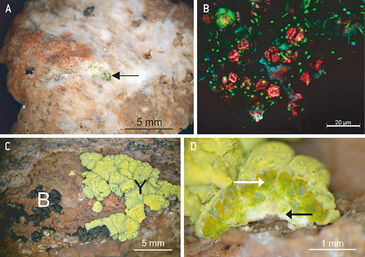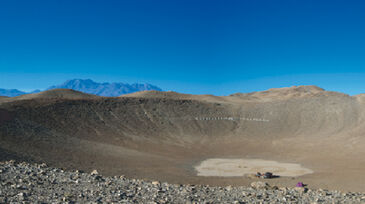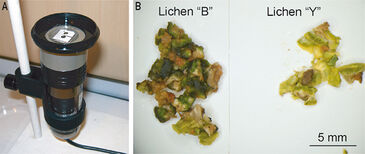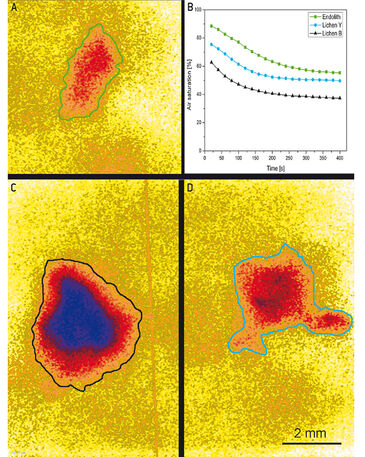Watch tutorials, webinars and informative videos about PreSens optical sensor systems.
Viability of Lithobiontic Microorganisms Inhabiting the Rocks of Atacama Desert
Determining photosynthetic activity with VisiSens
Jacek Wierzchos and Carmen Ascaso
Museo Nacional de Ciencias Naturales - CSIC, Madrid, Spain
The hyper-arid, life-limited Atacama Desert (Chile) gives the opportunity to determine the potential for life in extraterrestrial environments. In this study the viability of endolithic microbial communities as well as two different epilithic lichens colonizing rocks in this desert has been investigated. Photosynthetic activity was monitored with the VisiSens oxygen imaging system. The recorded oxygen maps showed equilibrium state in oxygen concentrations of the lithobiontic microbial communities when kept in the light. During a dark phase photosynthesis was stopped and a decrease in oxygen levels in the microenvironment of all investigated lithobionts could be detected. The drop in oxygen concentration indicates no oxygen release by the phototrophic microorganisms and high consumption of oxygen by fungal cells.

The hyper-arid zone of the Atacama Desert is probably the driest and most life-limited place on Earth. The extreme aridity of this desert makes it an ideal `laboratory´ to determine the potential for life in extraterrestrial environments such as the Mars surface. Our results over the last six years indicate the presence of various habitats inside rocks and on their surface (lithobiontic) capable of sustaining active microbial ecosystems. Establishing the physiological status and viability of these microbial ecosystems in their natural microhabitat has far-reaching implications for understanding the microbial ecology of the hyper-arid environment. Several studies have assessed the viability of lithobiontic communities. However, investigations designed to examine the metabolic activity of microorganisms are time-consuming and laborious, and require extensive laboratory work. Measuring the metabolic activity of phototrophic microorganisms is challenging `per se´. If, as in our case, the microorganisms are lithobiontic this task is all the more complex since measurements need ot be undertaken both `in situ´ and `in vivo´. This is because almost all rock-dwelling microorganisms are uncultivable. An interesting approach is to examine PS II photosynthesis yields using PAM equipment. However, this will only give us an idea of the relative electron transport rate in the PS II system of the cells. Further, this variable is not the same as the rate of photosynthesis, which may be easily inferred from changes in oxygen concentrations produced in the microenvironment of the microorganism. Whether photosynthesis is impaired or not is essential since this will tell us whether or not these microorganisms are in effect `alive and well´.
Investigated Microorganisms
For purpose of this study, we selected two recently discovered lithobiontic microbial ecosystems inhabiting the hyper-arid zone of the Atacama Desert:
1. An endolithic microbial community colonizing the interior of a gypsum (CaSO4 x H2O) crust (Fig. 2 A - B). This endolithic community comprises an association of phototrophic algae and fungal hypha cells.
2. Epilithic lichens colonizing a volcanic rock surface (Fig. 2 B - C). Lichens are composite organisms consisting of a fungus (the mycobiont) and photosynthetic partner (the photobiont) growing together in a symbiotic relationship. The photobiont is usually either a green alga or cyanobacterium. The body (thallus) of most lichens is different to that of either the fungus or alga growing separately. The algal (or cyanobacterial) cells are photosynthetic.
In metabolically active (vital) alga / fungus associations (such as the endoliths examined here) or lichen symbionts under light conditions, the phototrophs (algae) take up carbon dioxide and water, and release oxygen as the product of photosynthesis. Conversely, in the dark both microorganisms (algae and fungi) consume oxygen during respiration. Thus, by detecting changes in oxygen concentration in the microorganisms´ microenvironment, we can assess the metabolic activity of these microbial communities.
Materials & Methods
The gypsum crust and volcanic rock surfaces were moistened using a water aerosol and left in conditions of 100 % relative humidity overnight and four hours a day of indirect sunlight. The endolithic microorganisms and fragments of both lichen thalli were separated from the rocks and gently placed on the VisiSens oxygen sensor foil (SF-RPSU4, PreSens), which was glued with hydrogel to the window of the optical dish (Fig. 3 A). A few drops of perfluorodecalin (PFD) were added to the small samples and these preparations were covered with glass coverslips. After placing a black lid on the dish to prevent photosynthesis, the dish with the sample(s) was immediately placed on top of the VisiSens camera and images recorded over 400 seconds (30 frames). Several repetitions of the experiment were performed for the endolithic and epilithic samples.
Photosynthetic Activity
Results are shown in Fig. 4. Changes in oxygen concentration were induced by the dark. Under light conditions, the photobiont (algae) of the metabolically active microbial ecosystems (endoliths and lichens) release oxygen as the product of photosynthesis, and fungal cells consume some of this oxygen. In these conditions, the ecosystem reaches a state of equilibrium and this corresponds to the first point on the x-axis in Fig. 9 B. At this point, the microenvironment of the endoliths reveals 64 % air sat., and those of lichens "Y" and "B" return values of 75 % and 63 % air sat., respectively. When photosynthesis was stopped, the `net´ oxygen concentration for all the samples gradually fell to constant values of 55 % air sat. (endoliths), 50 % air sat. (lichen "Y") and 38 % air sat. (lichen "B"). This drop in oxygen concentration indicates no oxygen release by the phototrophic microorganisms and a high consumption of oxygen by fungal cells.
Conclusion
The viability of lithobiontic microbial ecosystems in rocks from the Atacama Desert was determined using the VisiSens system. The changes in oxygen concentration observed within the microenvironment of the lithobionts are clear proof of their phototsynthetic and thus metabolic activity. We should highlight the rapid `in situ´ and `in vivo´ determination of lithobionts vitality offered by this approach. Moreover, this technique requires a small quantity of biological material and can be performed in the field just after collecting lithobiontic communities.





